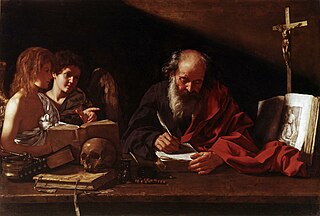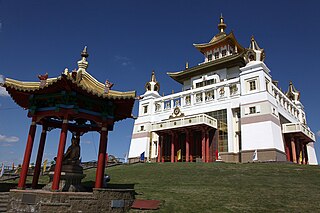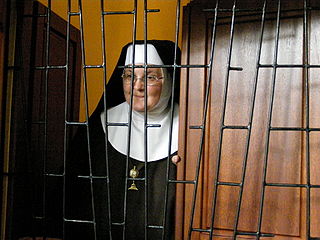Related Research Articles
Monasticism, also called monachism or monkhood, is a religious way of life in which one renounces worldly pursuits to devote oneself fully to spiritual work. Monastic life plays an important role in many Christian churches, especially in the Catholic, Orthodox and Anglican traditions as well as in other faiths such as Buddhism, Hinduism, and Jainism. In other religions, monasticism is criticized and not practiced, as in Islam and Zoroastrianism, or plays a marginal role, as in modern Judaism.

A monastery is a building or complex of buildings comprising the domestic quarters and workplaces of monastics, monks or nuns, whether living in communities or alone (hermits). A monastery generally includes a place reserved for prayer which may be a chapel, church, or temple, and may also serve as an oratory, or in the case of communities anything from a single building housing only one senior and two or three junior monks or nuns, to vast complexes and estates housing tens or hundreds. A monastery complex typically comprises a number of buildings which include a church, dormitory, cloister, refectory, library, balneary and infirmary, and outlying granges. Depending on the location, the monastic order and the occupation of its inhabitants, the complex may also include a wide range of buildings that facilitate self-sufficiency and service to the community. These may include a hospice, a school, and a range of agricultural and manufacturing buildings such as a barn, a forge, or a brewery.

The Carthusians, also known as the Order of Carthusians, are a Latin enclosed religious order of the Catholic Church. The order was founded by Bruno of Cologne in 1084 and includes both monks and nuns. The order has its own rule, called the Statutes, and their life combines both eremitical and cenobitic monasticism. The motto of the Carthusians is Stat crux dum volvitur orbis, Latin for 'The Cross is steady while the world turns'. The Carthusians retain a unique form of liturgy known as the Carthusian Rite.

A nun is a woman who vows to dedicate her life to religious service and contemplation, typically living under vows of poverty, chastity, and obedience in the enclosure of a monastery or convent. The term is often used interchangeably with religious sisters who do take simple vows but live an active vocation of prayer and charitable work.

A hermit, also known as an eremite or solitary, is a person who lives in seclusion. Eremitism plays a role in a variety of religions.
GLSEN is an American education organization working to end discrimination, harassment, and bullying based on sexual orientation, gender identity and gender expression and to prompt LGBT cultural inclusion and awareness in K-12 schools. Founded in 1990 in Boston, Massachusetts, the organization is now headquartered in New York City and has an office of public policy based in Washington, D.C.

A monk is a man who is a member of a religious order and lives in a monastery. A monk usually lives his life in prayer and contemplation. The concept is ancient and can be seen in many religions and in philosophy.

A bhikkhu is an ordained male in Buddhist monasticism. Male and female monastics are members of the Sangha.

Day of Silence is an annual day of action organized by GLSEN to spread awareness about the effects of the bullying and harassment of lesbian, gay, bisexual, transgender, queer, and questioning (LGBTQ) students. In the United States, students take a day-long vow of silence to symbolically represent the silencing of LGBTQ students.

Upāsaka (masculine) or Upāsikā (feminine) are from the Sanskrit and Pāli words for "attendant". This is the title of followers of Buddhism who are not monks, nuns, or novice monastics in a Buddhist order, and who undertake certain vows. In modern times they have a connotation of dedicated piety that is best suggested by terms such as "lay devotee" or "devout lay follower".
A Dharma name is a new name acquired during both lay and monastic Buddhist initiation rituals in Mahayana Buddhism and monastic ordination in Theravada Buddhism. The name is traditionally given by a Buddhist monastic, and is given to newly ordained monks, nuns and laity. Dharma names are considered aspirational, not descriptive.

The Kalmyks are the only Mongolic-speaking people of Europe whose national religion is Buddhism. In 2016, 53.4% of the population surveyed identified themselves as Buddhist. They live in Kalmykia, a federal subject of Russia in the southwest. Kalmykia borders Dagestan to the south, Stavropol Krai to the southwest, Rostov Oblast to the west, Volgograd Oblast to the northwest, and Astrakhan Oblast to the east. The Caspian Sea borders Kalmykia to the southeast.

Consecrated life is a state of life in the Catholic Church lived by those faithful who are called to follow Jesus Christ in a more exacting way. It includes those in institutes of consecrated life, societies of apostolic life, as well as those living as hermits or consecrated virgins/widows.
A religious name is a type of given name bestowed for a religious purposes, and which is generally used in such contexts.

Enclosed religious orders are religious orders whose members strictly separate themselves from the affairs of the external world. The term cloistered is synonymous with enclosed. In the Catholic Church, enclosure is regulated by the code of canon law, either the Latin code or the Oriental code, and also by the constitutions of the specific order. It is practised with a variety of customs according to the nature and charism of the community in question. This separation may involve physical barriers such as walls and grilles, with entry restricted for other people and certain areas exclusively permitted to the members of the convent. Outsiders may only temporarily enter this area under certain conditions. The intended purpose for such enclosure is to prevent distraction from prayer and the religious life and to keep an atmosphere of silence.

A hermitage most authentically refers to a place where a hermit lives in seclusion from the world, or a building or settlement where a person or a group of people lived religiously, in seclusion. Particularly as a name or part of the name of properties its meaning is often imprecise, harking to a distant period of local history, components of the building material, or recalling any former sanctuary or holy place. Secondary churches or establishments run from a monastery were often called "hermitages".

The Think Before You Speak campaign is a television, radio, and magazine advertising campaign launched in 2008 and developed to raise awareness of the common use of derogatory vocabulary among youth towards lesbian, gay, bisexual, transgender, queer/questioning (LGBTQ) people. It also aims to "raise awareness about the prevalence and consequences of anti-LGBTQ bias and behaviour in America's schools." As LGBTQ people have become more accepted in the mainstream culture more studies have confirmed that they are one of the most targeted groups for harassment and bullying. An "analysis of 14 years of hate crime data" by the FBI found that gays and lesbians, or those perceived to be gay, "are far more likely to be victims of a violent hate crime than any other minority group in the United States". "As Americans become more accepting of LGBT people, the most extreme elements of the anti-gay movement are digging in their heels and continuing to defame gays and lesbians with falsehoods that grow more incendiary by the day," said Mark Potok, editor of the Intelligence Report. "The leaders of this movement may deny it, but it seems clear that their demonization of gays and lesbians plays a role in fomenting the violence, hatred and bullying we're seeing." Because of their sexual orientation or gender identity/expression, nearly half of LGBTQ students have been physically assaulted at school. The campaign takes positive steps to counteract hateful and anti-gay speech that LGBTQ students experience in their daily lives in hopes to de-escalate the cycle of hate speech/harassment/bullying/physical threats and violence.
In the Catholic Church, "A religious institute is a society in which members, according to proper law, pronounce public vows, either perpetual or temporary which are to be renewed, however, when the period of time has elapsed, and lead a life of brothers or sisters in common."

Monastic silence is a spiritual practice recommended in a variety of religious traditions for purposes including becoming closer to God and achieving elevated states of spiritual purity. It may be in accordance with a monk's formal vow of silence, but can also engage laity who have not taken vows, or novices who are preparing to take vows.

LGBT Pride Month, often shortened to Pride Month, is a month, typically June, dedicated to celebration and commemoration of lesbian, gay, bisexual, and transgender (LGBT) pride. Pride Month began after the Stonewall riots, a series of gay liberation protests in 1969.
References
- ↑ Ware, Jordan Haynie (1 February 2017). The Ultimate Quest: A Geek's Guide to (The Episcopal) Church. Church Publishing Incorporated. p. 30. ISBN 9780819233264.
- ↑ Sarah, Robert Cardinal (2017). The Power of Silence:Against the Dictatorship of Noise. Ignatius Press. ISBN 978-1621641919.
- ↑ Macadam, Heather (2002). The Weeping Buddha . New York: Akashic Books. pp. 99. ISBN 1888451394.
- ↑ Catholic Encyclopedia
- ↑ Bhalla, Prem P. (2006). Hindu Rites, Rituals, Customs and Traditions. Pustak Mahal. pp. 172–. ISBN 978-81-223-0902-7.
- ↑ Wijayaratna, Mohan (1990). Buddhist Monastic Life: According to the Texts of the Theravada Tradition. Cambridge: Cambridge University Press. p. 133. ISBN 0521364280.
- ↑ Suh, Sharon (2015). Silver Screen Buddha: Buddhism in Asian and Western Film. London: Bloomsbury Publishing Plc. p. 168. ISBN 9781441189257.
- ↑ Beer, Robert (2003). The Handbook of Tibetan Buddhist Symbols. Chicago: Serindia. p. 184. ISBN 1932476032.
- ↑ "The day of a silence | GANDHIJI".
- ↑ "Twenty-eight students take 24-hour vow of silence". St. Albert Gazette . 2010-11-24. Archived from the original on 2023-02-01. Retrieved 2024-04-28.
- ↑ "Join Us for Day of (No) Silence on April 12, 2024 and Support LGBTQ+ Students!". GLSEN. Retrieved 2024-04-28.
- ↑ Duster, Chandelis (2024-04-12). "After decades of silent protest, students speak out for LGBTQ rights on the annual 'Day of (NO) Silence'". CNN. Retrieved 2024-04-28.
- ↑ Cornelli, Gabriele; McKirahan, Richard (2013). In Search of Pythagoreanism: Pythagoreanism as an Historiographical Category. Berlin, Germany: Walter de Gruyter. ISBN 978-3-11-030650-7.
- ↑ Hawker, Tom (20 July 2014). "The 25 Funniest Monty Python Movie Moments". IGN. Retrieved 15 February 2022.
- ↑ Brody, Richard (2017-09-14). "Cockfighter". The New Yorker . Retrieved 2024-04-28.
- ↑ MacLaren, Marilyn (2022-05-19). "'Little Miss Sunshine' examines dysfunctional family dynamics". The Daily Illini . Retrieved 2024-04-28.
- ↑ Betts, Eric (2021-08-30). "The Real Reason Manny Jacinto Loved Playing Jason On The Good Place". Looper . Retrieved 2024-04-28.
- ↑ Evans, Bradford (2011-08-08). "Curb Your Enthusiasm Recap: "Vow of Silence"". Vulture . Retrieved 2024-04-28.
